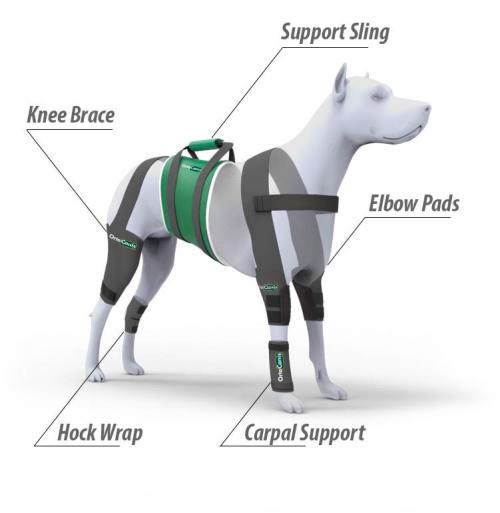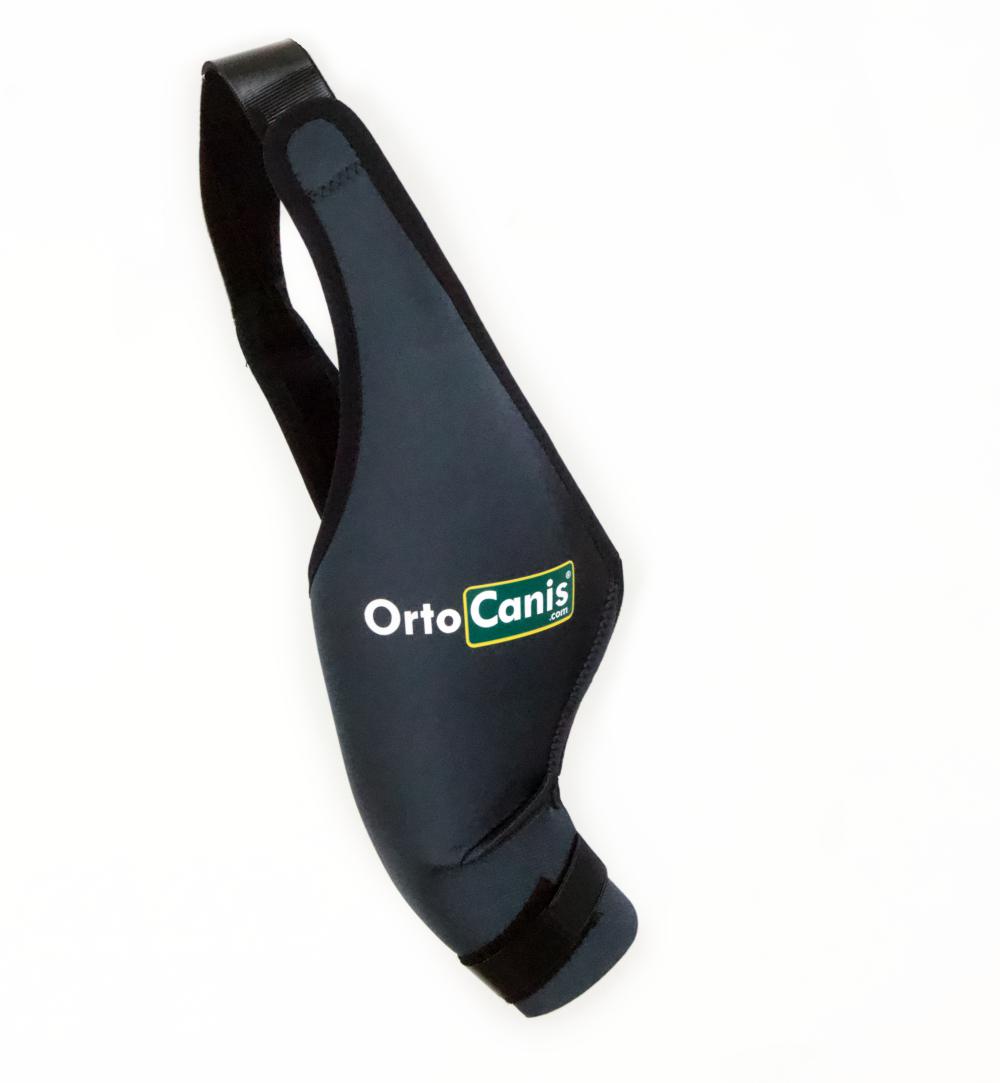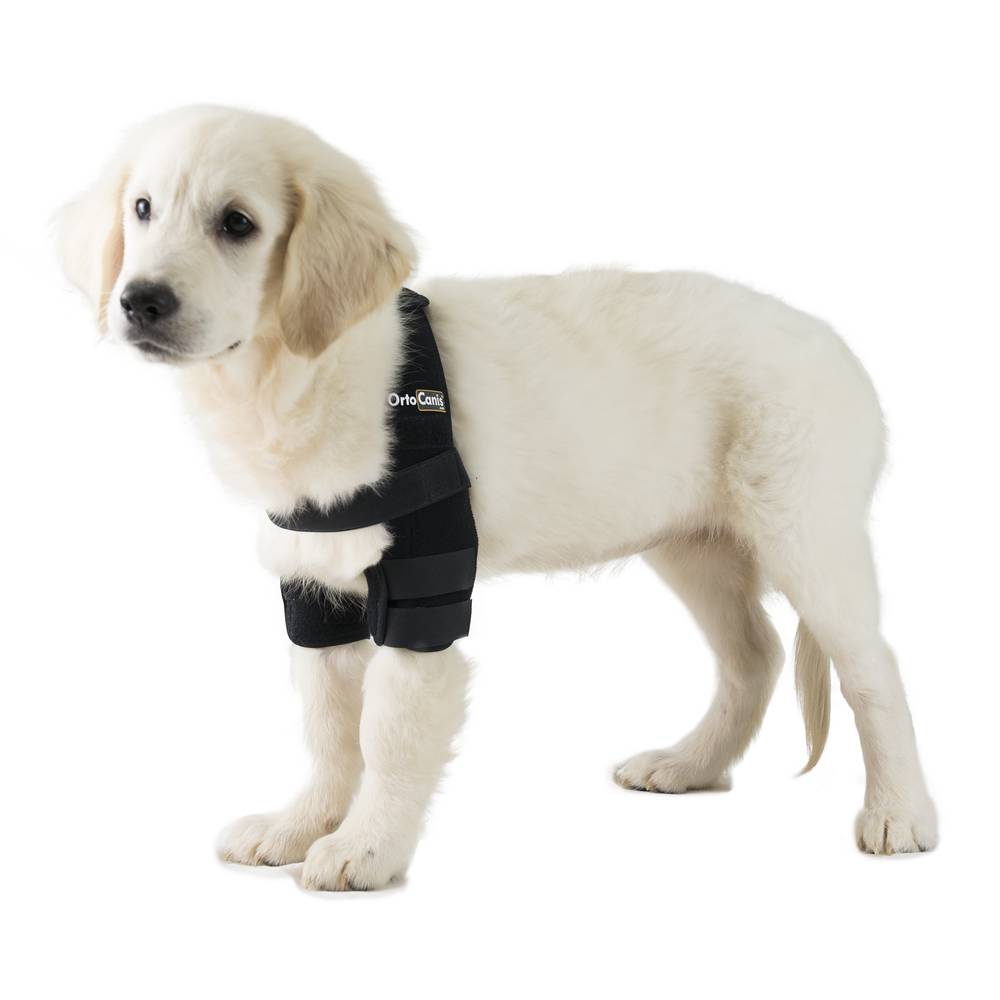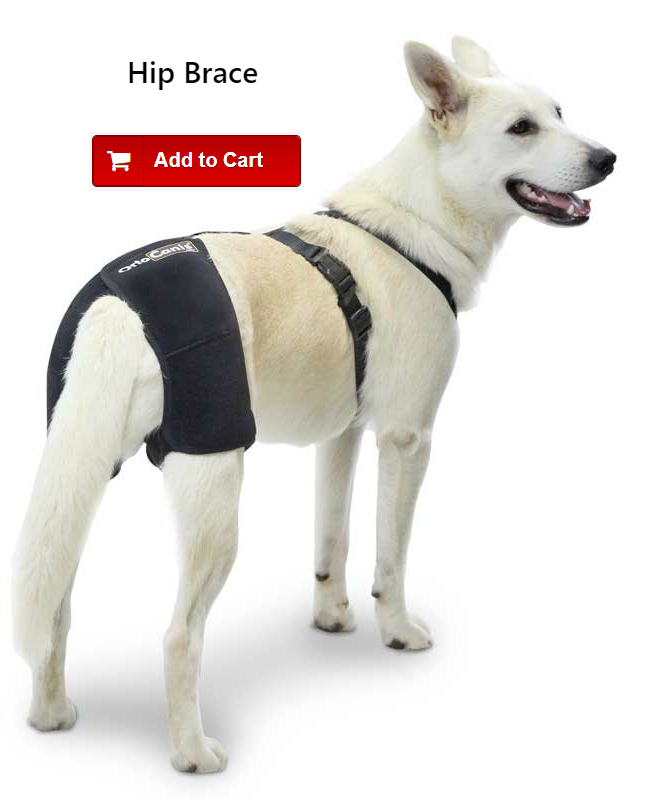The use of orthopedic aids in dogs is becoming more normal. They are proving their effectiveness as a non-invasive treatment and over time they have been improving their design and optimizing their results.
But exactly, What effects does the use of an orthosis have?
Apart from giving a physical support helping the correct positioning of the muscle group, the working temperature of tissues and joints increase. This increase produces effects in the hemodynamic, neuromuscular and metabolic processes:
- Activates the release of the vasodilators histamine and prostaglandin, increasing blood flow.
- Increase in nerve conduction. Approximately 2 m / s for each degree of temperature increase.
- Improves metabolism: increases the number of cells improving the body's defenses.
- It reduces the synthesis of collagen, a protein that fibrous tissues.
- It increases the production of elastin, a protein that provides extensibility to soft collagenous tissues.
These effects produce the following results:
- Increase in pain threshold. The increase in the activity of cutaneous termoreceptors has an inhibitory effect.
- Acceleration of the tissue healing process. Thanks to the increase in blood supply, bringing oxygen and nutrients to the tissues, and removing waste products.
- Increased tissue flexibility, especially if we exercise within minutes of wearing the orthosis.
- Increased range of mobility and joint stiffness, thanks to increased extensibility of soft tissues.
Reducing the pain produced by musculoskeletal conditions stimulates activity, allowing the dog to perform the daily exercise it needs.
When can we use an orthosis?
There are several types of Orthoses. The softest, which are made with flexible materials and special fabrics are used in cases of osteoarthritis, hip dysplasia, ligament injuries, post-operative rehabilitation, joint weakness or pain that end up generating a mobility problem.
The most rigid orthoses are used to correct proprioception problems or the treatment of fractures in the case of anterior or posterior limb splints.
Technical aids are also used in critical cases where surgery is not possible or recommended to mitigate the effects of the injury.
Don't they really have contraindications?
The orthosis is in direct contact with the animal and therefore at the beginning could generate discomfort or friction, so it is important that they have a good adaptation to the physiognomy of the dog. This is achieved by using a correct size and anatomical designs, but also by using high dynamic resistance neoprene (ARD).
We should therefore make a progressive introduction and periodically check the affected areas during the first days of use.
We must also take special precautions in cases of acute inflammation, circulation disturbances, poor thermal regulation, edema, heart failure, demyelinated nerves or in case of open wounds.
The most used orthoses are:
Dog Knee brace
Knee protectors are usually used in cases of localized osteoarthritis but also after surgery to accelerate anterior cruciate ligament (ACL) rehabilitation, patella luxation, medial collateral ligament (MCL), lateral collateral ligament (LCL), or cruciate ligaments. later (PCL). Knee pads provide support and stability, prevent muscle loss during the recovery period and reduce the risk of new injuries. Knee protectors are also commonly used in cases where surgery is not performed.
The knee protector reduces pain and inflammation by improving the balance between the muscle groups involved. The improvement of flexibility in tense muscles helps the dog to recover a natural movement of the limb. The slight pressure exerted by this superficial orthosis decontracts the workloads of the joint, increasing its stability and preventing the evolution of the damage towards a more serious state.
In cases of damage to the cruciate ligaments, the dog can use the knee brace before the surgery (along with the prescribed treatment) to prevent the loss of muscle mass. After the operation, you can reuse the protector after 5 days, once the inflammation has subsided.
Hinged Knee Brace
This knee orthosis is made with metal ball joints on both sides of the joint, which allow the natural play of the joint by limiting lateral movement, this is an immobilization on its medial-lateral axis. Compensates the loss of functionality of the joint, reduces the pain of the dog with dislocated patella or in those cases that we are interested in limiting the efforts that will support the knee.
Carpal brace
It is a less elastic neoprene stabilizer than the ARD with two lateral cavities that house steel splints. You are two splints can be removed to graduate the degree of immobilization from a 1 to a 3 over 4. The most common uses are:
- Carpal instability
- Carpal hyperextension
- Arthrosis of the Carpus
- Post-surgical use
Alternative conservative treatment when, for various reasons, surgery is impossible. It is a modern and practical version of the Robert Jones bandage.
Orthosis and elbow protector
The elbow protector or elbow pads for dogs can be used before and after surgery and in cases of chronic arthritis; for example, in osteoarthritis, OCD, ligament injuries and elbow dysplasia, among others. Also, by having internal padding, it can be used for skin / subcutaneous lesions of the elbow, such as hygromas or persistent and / or ulcerated support calluses.
The elbow orthosis, although not initially designed for this purpose, has also been used in problems of the shoulder and brachial plexus since with an extra chest strap the mobility of the elbow and shoulder can be limited adding a lateral to medial force.
These technical aids also offer protection from damage or wear to the elbow cartilage. Frequently it is related to the inability of the dog to complete exercises, training or some competition.
When the dog begins to have problems with the joints of the elbow, the most immediate symptoms are lameness or ankylosis. When the dog's paw begins to show these symptoms, the use of the protector or the elbow orthosis is the ideal aid. It is convenient to combine with exercise or training to counteract the pressure caused by the inflammation of the joint.
Hip brace
The hip support holds and increases the temperature of the lower back and the hip of the dog. Made of neoprene ARD surrounds the upper leg area holding on thanks to a Roman-type or pectoral harness. Hip supports are recommended in dogs with mild to moderate hip dysplasia and localized osteoarthritis.
The hip support is also the appropriate reinforcement for dogs recovering from surgery or lumbar injury. After a period of adaptation, it can be used throughout the day and retired at night.
Indications:
- Mild to moderate hip dysplasia
- Osteoarthritis
- Decreased resistance during activity
- Hip pain
- Low back pain / weakness
- Postoperative support
Hock wrap
The tarsal supports are indicated in cases of osteoarthritis, but also for postsurgical rehabilitation or injury to the Achilles tendon, damage to nerves of the hind limb or foot and rehabilitation of the hock joint. They can also be used as long-term support in non-surgical conditions. A tarsus or hock protector stabilizes the leg bone, as well as the muscles and tendons of the limb. It works similar to an ankle in humans, allowing the dog to move without straining the joint. It also prevents the can re-injuring the affected joint or ligaments.
It is made in German neoprene of high dynamic resistance (ARD).
Prevents damage to muscles, ligaments, tendons and joints (ideal in sled dogs and agility).
Propioceptive corrector
The proprioceptive corrector has been developed to help dogs that drag their knuckles when walking due to insufficient sciatic nerve or "Knuckling".
The support is attached to the middle fingers of the foot with a stretched elastic cord with a clamp placed over the tarsal area. The tension generated allows the dog to support the pads correctly and prevents dragging the dorsal part of the foot.
For prolonged sessions you can use an accessory boot, which will prevent possible irritation in the interdigital areas.
Where to find technical aids for dog?
Ortocanis has been innovating without limits for more than 8 years to offer the most modern and wide range of technical aids for dogs in the world, designed conscientiously to improve the life of animals with reduced mobility and the people who take care of them.
Orders can be placed directly in the online store www.ortocanis.com, by mail, or by phone from Monday to Friday from 11 a.m. to 6 p.m. and they are sent by express courier to the whole world.
Ortocanis CEO
October 2018
Bibliography:
1. Marcellin-Little, D.J.; Levine, D.; Millis, D.L. Physical rehabilitation for geriatric and arthritic patients. In Canine Rehabilitation and Physical Therapy; Millis, D.L., Levine, D., Eds.; Elsevier: Amsterdam, The Netherlands, 2014. p. 628–641.
2. Millis DL, Ciuperca IA. Evidence for canine rehabilitation and physical therapy. Vet Clin North Am Small Anim Pract. 2015 Jan;45(1):1-27. doi: 10.1016/j.cvsm.2014.09.001. PMID: 25432679.
3. Langley-Hobbs, S. Patients with orthopedic disease. In BSAVA Manual of Canine and Feline Rehabilitation, Supportive and Palliative Care: Case Studies in Patient Management; Lindley, S., Watson, P., Eds.; British Small Animal Veterinary Association: Quedgeley, UK, 2010. p. 224–231.
4. Pye C, Clark N, Bruniges N, Peffers M, Comerford E. Current evidence for non-pharmaceutical, non-surgical treatments of canine osteoarthritis. J Small Anim Pract. 2023 Sep 29. doi: 10.1111/jsap.13670. Epub ahead of print. PMID: 37776028.
https://onlinelibrary.wiley.com/doi/10.1111/jsap.13670
5. Mille MA, McClement J, Lauer S. Physiotherapeutic Strategies and Their Current Evidence for Canine Osteoarthritis. Vet Sci. 2022 Dec 21;10(1):2. doi: 10.3390/vetsci10010002. PMID: 36669003; PMCID: PMC9863568.
https://www.mdpi.com/2306-7381/10/1/2
6. Mabry K, Hill T, Tolbert MK. Prevalence of gastrointestinal lesions in dogs chronically treated with nonsteroidal anti-inflammatory drugs. J Vet Intern Med. 2021 Mar;35(2):853-859. doi: 10.1111/jvim.16057. Epub 2021 Feb 3. PMID: 33534961; PMCID: PMC7995375.
https://onlinelibrary.wiley.com/doi/10.1111/jvim.16057
7. Krüger-Genge A, Blocki A, Franke RP, Jung F. Vascular Endothelial Cell Biology: An Update. Int J Mol Sci. 2019 Sep 7;20(18):4411. doi: 10.3390/ijms20184411. PMID: 31500313; PMCID: PMC6769656.
https://www.mdpi.com/1422-0067/20/18/4411
8. Boulanger CM. Endothelium. Arterioscler Thromb Vasc Biol. 2016 Apr;36(4):e26-31. doi: 10.1161/ATVBAHA.116.306940. PMID: 27010027.
https://www.ahajournals.org/doi/10.1161/ATVBAHA.116.306940
9. Hellsten Y, Nyberg M, Jensen LG, Mortensen SP. Vasodilator interactions in skeletal muscle blood flow regulation. J Physiol. 2012 Dec 15;590(24):6297-305. doi: 10.1113/jphysiol.2012.240762. Epub 2012 Sep 17. PMID: 22988140; PMCID: PMC3533192.
https://physoc.onlinelibrary.wiley.com/doi/10.1113/jphysiol.2012.240762
10. Sarelius I, Pohl U. Control of muscle blood flow during exercise: local factors and integrative mechanisms. Acta Physiol (Oxf). 2010 Aug;199(4):349-65. doi: 10.1111/j.1748-1716.2010.02129.x. Epub 2010 Mar 26. PMID: 20353492; PMCID: PMC3157959.
https://onlinelibrary.wiley.com/doi/10.1111/j.1748-1716.2010.02129.x
11.Abramson DI, Chu LS, Tuck S Jr, Lee SW, Richardson G, Levin M. Effect of tissue temperatures and blood flow on motor nerve conduction velocity. JAMA. 1966 Dec 5;198(10):1082-8. PMID: 5953385.
https://jamanetwork.com/journals/jama/article-abstract/662533
12. Franssen H, Wieneke GH, Wokke JH. The influence of temperature on conduction block. Muscle Nerve. 1999 Feb;22(2):166-73. doi: 10.1002/(sici)1097-4598(199902)22:2<166::aid-mus4>3.0.co;2-q. PMID: 10024129.
https://onlinelibrary.wiley.com/doi/10.1002/(SICI)1097-4598(199902)22:2%3C166::AID-MUS4%3E3.0.CO;2-Q13. Rutkove SB. Effects of temperature on neuromuscular electrophysiology. Muscle Nerve. 2001 Jul;24(7):867-82. doi: 10.1002/mus.1084. PMID: 11410914.
https://onlinelibrary.wiley.com/doi/10.1002/mus.1084
14. Racinais S, Oksa J. Temperature and neuromuscular function. Scand J Med Sci Sports. 2010 Oct;20 Suppl 3:1-18. doi: 10.1111/j.1600-0838.2010.01204.x. PMID: 21029186.
https://onlinelibrary.wiley.com/doi/full/10.1111/j.1600-0838.2010.01204.x
15. Vargas E Silva NCO, Rubio AL, Alfieri FM. Pain Tolerance: The Influence of Cold or Heat Therapy. J Chiropr Med. 2019 Dec;18(4):261-269. doi: 10.1016/j.jcm.2019.03.002. Epub 2020 Jul 28. PMID: 32952471; PMCID: PMC7486461.
https://www.sciencedirect.com/science/article/abs/pii/S155637072030050X
16. Fernandez-de-Cossio-Diaz J, Vazquez A. A physical model of cell metabolism. Sci Rep. 2018 May 29;8(1):8349. doi: 10.1038/s41598-018-26724-7. PMID: 29844352; PMCID: PMC5974398.
https://www.nature.com/articles/s41598-018-26724-7
17. Brodie C, Sampson SR. Contribution of electrogenic sodium-potassium ATPase to resting membrane potential of cultured rat skeletal myotubes. Brain Res. 1985 Nov 11;347(1):28-35. doi: 10.1016/0006-8993(85)90885-6. PMID: 2996716.
https://www.sciencedirect.com/science/article/abs/pii/0006899385908856
18. Dlouhá H, Donselaar Y, Teisinger J, Vyskocil F. Effect of temperature and ouabain on th Na+--K+ activated membrane ATPase and electrogenic ionic pump of the golden hamster and mouse diaphragm. Physiol Bohemoslov. 1980;29(6):543-52. PMID: 6259677.
https://pubmed.ncbi.nlm.nih.gov/6259677/
19. Wynn TA, Vannella KM. Macrophages in Tissue Repair, Regeneration, and Fibrosis. Immunity. 2016 Mar 15;44(3):450-462. doi: 10.1016/j.immuni.2016.02.015. PMID: 26982353; PMCID: PMC4794754.
20. Lendahl U, Muhl L, Betsholtz C. Identification, discrimination and heterogeneity of fibroblasts. Nat Commun. 2022 Jun 14;13(1):3409. doi: 10.1038/s41467-022-30633-9. PMID: 35701396; PMCID: PMC9192344.




